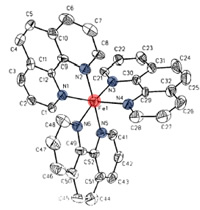Standfirst: Powerful X-rays can reveal how electronic spin-states influence magnetism at the molecular scale
The particles in a liquid usually exist in a completely disordered state, but in some cases it is possible to introduce order by applying a magnetic field. The changes in these so-called molecular magnetic systems, which usually contain transition metals, are closely linked to changes in the spin, or intrinsic angular momentum, of electrons.
By using ultrafast lasers, researchers can measure molecular magnetic systems on timescales as short as femtoseconds. However, it is difficult to calculate the spin dynamics from optical signals, and most techniques can only probe molecular magnetic systems in their ordered states. It is also important to probe the spin dynamics in systems while they are disordered, to build up an understanding of how magnetic properties arise, and how they could be controlled.
To achieve this aim, researchers at Tokyo Tech have been working as part of a country-wide team to directly probe spin dynamics and prove the existence of a new 'high-spin' state, using a technique called X-ray absorption fine structure (XAFS). The team made use of incredibly powerful pulsed X-rays generated in the Photon Factory Advanced Ring (PF-AR) in Tsukuba.
When such high-energy X-rays interact with transition metals, the resulting spectra generally show three distinct regions containing separate information relating to the sample's spin state, electronic state and molecular structure. The possibility of probing all three of these quantities simultaneously makes XAFS especially appealing for probing magnetic systems.
The researchers, including Tokushi Sato, Matthieu Chollet, Ayana Tomita and Shin-ya Koshihara at Tokyo Tech, focused on aqueous solutions of iron-phenanthroline ions ([FEII(phen)3]2+) in which each magnetic iron atom is joined to six nitrogen atoms. This system can be excited into a 'singlet' energy state, which quickly relaxes to a 'low-spin' ground state. Intriguingly, recent research has suggested that during the relaxation process there may be an intermediate 'quintet high-spin' state that lasts less than a nanosecond and is generated due to a phenomenon called spin crossover.
However, there has so far been no direct experimental evidence to prove that the high-spin state exists. In particular, a spin crossover would undoubtedly be associated with changes in the spin states of the iron atom's outer electron, and is closely related to the molecular structure next to the iron atom. This combination of spin, electronic and molecular factors makes [FEII(phen)3]2+ an ideal candidate material for testing the usefulness of XAFS.
The researchers applied a titanium-sapphire femtosecond laser alongside the PF-AR X-ray pulse to excite the appropriate energy bands in [FEII(phen)3]2+, and compared their results with spectra for another phenanthroline ion known to have a high-spin ground state. This showed that there is indeed a photo-excited intermediate state in [FEII(phen)3]2+, and it takes a quintet high-spin configuration.
By analyzing other parts of the spectrum, the researchers found that the electron structure of [FEII(phen)3]2+ also changes during the high-spin state, and the lengths of bonds between iron and nitrogen atoms increases. The longer bond results in further changes in the electron orbitals and causes multiple scattering of photoelectrons. What's more, when the system enters the high-spin state it becomes more disordered overall.
The study verifies that XAFS is an excellent tool for investigating dynamics of disordered magnetic systems, especially because it can pick out ultrafast photo-induced reactions. It could prove useful in the emerging fields of nanomagnets, magnetically-activated photocatalysts, and molecular magnetism in biology. Finally, the researchers suggest that by combining XAFS with time-resolved X-ray liquidography, which reveals the larger, macroscopic dynamics and excited states of a system, scientists could record the full integrated process of a molecular reaction.
Reference
. Any information published on this site will be valid in relation to Science Tokyo.




